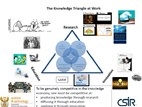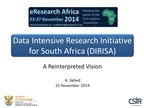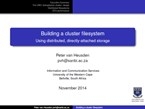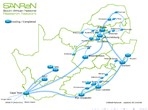The Research Bazaar: building next generation digital research skills through community
The Research Bazaar (#ResBaz) is a fundamentally new, dynamic, and engaging IT support model that aims to shift away from the standard IT helpdesk towards a community-driven model of best practice technology use in research.
The University of Melbourne’s #ResBaz program was designed with two goals in mind: to help researchers use digital tools, and; to lift the digital literacy of the entire research community.
Communities in academic research span disciplines, regional areas, research lineages, and short and long histories of academic collaboration. Traditionally, the development of these communities happens in a number of different ways, such as working in the same lab, department or faculty, or attending conferences in the same field.
Nowadays, research practice is increasingly and in many cases exclusively data driven, where knowledge of how to use tools to manipulate research data is foundational to quality research. Along with this, new types of communities are forming around interests in digital tools, computing facilities and even data repositories.
By making infrastructure services, community engagement and training inseparable, we have been able to arm existing communities with new ways of doing research; to build new communities around tools and data; to teach researchers how to use tools, and; to teach them how to teach others to do the same. Underpinning all of this is an ethos of treating all engagements as micro-collaborations, with an emphasis on building social networks and relationships both online, and in the real world.
This presentation will take the audience through a number of tried and tested methodologies that the #ResBaz team has actively employed in building community. I will talk about what community means, and how to go about building and training the research community in cost effective ways. I will also argue that a community-based approach will drive improved research outcomes at your institution.
Dr Steven Manos
Dr. Steven Manos leads a team of nearly 30 people at the University of Melbourne responsible for digital research platforms, training and engagement. His mission is to lift the digital literacy of the research community by arming them with the digital tools to do what they love, and do it in a more far-reaching and effective way. He does this by building communities, actively training researchers and establishing innovative and extremely usable platforms for research. In the past he did a PhD in Physics at Sydney University and a stint of post-doctoral research at University College London. He lives in Melbourne with his partner and son, and enjoys designing and making furniture.
South African National Cyber-Infrastructure System … and eResearch

The origin and development of the new South African National Cyber-Infrastructure System (NICIS) will be sketched and its ecosystem explored. The roles and responsibilities of all stakeholders and users will be spelt out. The impact and sustainability of as well as innovation arising from cyberinfrastructures are important factors.
Current international Cyberinfrastructure commons developments will be highlighted.
Relationships between Cyber-Infrastructures and Research Infrastructures are to be considered as well as their mutual impact.
Professor Colin Wright
Professor Colin Wright’s pursued a full academic career in Computational Mathematics—his PhD, research, teaching and PhD graduate supervisions. On retiring as full professor of Computational Mathematics at the University of the Witwatersrand, Johannesburg he was granted the rank of Emeritus Research Professor. His senior academic management career included Head of School, Executive Dean of the Faculty of Science, Member of the University Council and its Executive and Finance Committees. He did a stint as executive responsible for Libraries and IT.
At retirement he was appointed as Research Manager of the Centre for High Performance Computing (CHPC) and then subsequently to manage the SA National Research Network (SANReN). In 2008, he successfully motivated for the establishment of the national Very Large Database facility which was initially co-located with CHPC and is now being matured into the Data Intensive Research Initiative for South Africa (DIRISA).
As a consequence of the 2012/13 international review, the current SA Cyberinfrastructure entities plus a new e-Infrastructure Skills and Training unit are being merged into the SA National CyberInfrastructure System (NICIS). At the beginning of 2014 he was appointed by the Department of Science and Technology to advise on and lead the NICIS implementation.
Since its inception, he has been a member of the G8+O5 Research Data Infrastructure Working Group which has advised these countries on a data strategy. During the last few years he has advised the European Commission in different capacities on e-Infrastructure matters.
Continuous integration and delivery of research applications in SAGRid
The usefulness of any computational platform is dependent on the availability and readiness of relevant research applications which can exploit it. It is the users of these applications which drive their deployment, requesting their availability on platforms to which they have access. However, usually users or user communities do not have unfettered access to distributed resources; rather this is granted to a special role (the software administrator of a virtual organisation). These applications often have complex dependencies and nontrivial lifecycles. This has in the past implied that a significant lead-time between the initial request and the eventual deployment of the application. Furthermore, there often sometimes a disconnect between the user of the application and the actual resource owner, with no common ground or channel to address technical issues. These shortcomings have been recognised in the SAGrid collaboration and we here present the motivation and details of the solution. Three paradigms have been adopted, with specific technical implementations: distributed source control, continuous integration and distributed virtual file systems.
We will outline the change in procedures which we have adopted to streamline the development and integration of applications, describing in detail the integration environment, and the supporting technologies which we have adopted – Jenkins-CI, Github and CVMFS. We propose that this can act as the common area of convergence to address technical issues. Some discussion will be also dedicated to the motivators of the new system – user and developer inclusion, closer collaboration between the infrastructure and the researchers, opening the ecosystem of development and improving the level of support for new applications. Some specific examples will be used to demonstrate the new service, which is currently in beta phase.
This development brings to SAGrid a smoother, easier way for the wider research community to contribute to applications on the national infrastructure, as well as reduce time-to-delivery, while providing site administrators with a trusted testing and integration platform. The service is in beta at http://ci.sagrid.ac.za:8080
Dr Bruce Becker
Bruce Becker is a senior researcher at the SANREN Competency Area of the CSIR Meraka Institute. He holds a Ph.D. from the University of Cape Town and has worked at the CEA (Paris) and INFN (Cagliari) on the ALICE experiment at the LHC. After moving back to South Africa, he kickstarted the South African National Grid, a federation of institutes, national laboratories and research groups providing an integrated computational and data infrastructure. He continues the coordiantion of SAGrid, and at the regional level, the Africa-Arabia Regional Operations Centre. His roles in this context are to ensure smooth technical interoperability between resource centres in the region, promote the deployment of new sites, provide technical and operational support and promote the uptake of services associated with the ROC. Working closely with the Ubuntunet Alliance, he has been involved in several FP7-funded support actions, including ei4Africa, CHAIN and CHAIN-REDS projects. He works closely with SANReN in the area of identity federations, network-intensive applications and other advanced services.
Stefanus Riekert
Fanie Riekert is a System Engineer a the ICTS Department of the University of the Free State. He has experience in undergraduate and postgraduate teaching level, in the area of operating systems and networks. He provides user and application development support to the HPC centre at the University of the Free State, and maintains several SAGrid and AAROC services.
The RDSI DaSH Subproject and the RDS Project – the complementary services needed to make RDSI a success and life after RDSI

Richard Northam
Richard Northam recently took on the role of Director of the Research Data Services Projec the successor project to RDSI after serving as the Node Development Manager with the RDSI Project. Prior to RDSI and RDS, Richard was the CEO of CAUDIT Inc and previously served as a university IT Director. He is a member of the faculty of the South African and Hong Kong Leadership Institutes for higher education, a Director on the board of the Australian Access Federation Inc, and former Director on the board of EDUCAUSE which is an association for IT professionals in higher education in the USA. Richard has more than 25 years experience in the ICT industry working in the Private, Federal Government and Higher Education Sectors in Australia.
The Challenges, Opportunities and Security of “big data”: A Perspective
What challenges, opportunities and security considerations does “big data” bring and demand of the research data workflow, storage and an organisations infrastructure?
Today it is common for individuals when discussing data or storage to refer to “big data”. Much attention is focussed on the characteristics of “big data” which, Doug Laney (Gartner, 2001) used in what arguably has become a standard definition which encompasses the characteristics volume, velocity and variety (3 V’s). A scan of the Internet reveals that there are a number of definitions to choose from. Each of these definitions may be as diverse as there are opinions on what “big data” is (Ward and Barker, 2013). While it may be debateable as to whether these definitions aid the understanding, they certainly are silent on what the challenges are that an organisations infrastructure faces or the opportunities it may be presented with. Security is one such challenge. In the context of “big data”, storage and infrastructure, security demands urgent attention.
This paper touches on the challenges and opportunities that big data represents and specifically shares a perspective on security in the context of the research data workflow and storage solutions with the intent of stimulating conversation within the eResearch ambit.
Andre le Roux
Mr. Andre le Roux is the Director Technical Support Services, responsible for providing enterprise wide infrastructure services and solutions within the Information and Communication Services to the University of Cape Town (UCT). With a background in electronics, he has over seventeen years of broad-based IT experience of which he has spent 15 years at UCT where he has fulfilled various technical and leadership roles. Mr le Roux has been involved from inception to date with establishing eResearch at UCT and providing infrastructure solutions to the UCT research and institutional community.
Data Intensive Research Initiative for South Africa: A Reintepreted Vision

DIRISA Manager
CSIR
Meraka Institute
Building a cluster file system using distributed, direct-attached storage

Peter van Heusden
Peter van Heusden is a systems administrator and software developer at the South African National Bioinformatics Institute, a life sciences research institute at the University of the Western Cape. He has been supporting research computing in academic settings for two decades.
NREN Capability Maturity: The Case of the South African NREN

CEO
TENET
View the presentation
Federated identity management - putting the building blocks together

This presentation will detail all the building blocks that are necessary to build a Federation as well as the specific Policy and Governance models that have been developed for the South African Federation in particular.
The technical implementation of the federation will be detailed and a demonstration will be given as to how to use federated credentials to access a service. A walk through of how new identities and services can be added to the federation will be shown as well.
Siju Abraham Mammen
Mr. Siju Mammen has been a Senior Engineer at the South African Research Network (SANReN) at the Council for Scientific and Industrial Research (CSIR) since October 2011. He has been employed full time since January 2006. He has worked in a variety of fields at several companies prior to him joining the CSIR. Specifically, he was a Business Solution's Analyst at Nedbank, where he developed custom banking solutions for business clients; a Consultant at Bytes System Integration, where he assisted the consulting team to develop ICT technology roadmaps for various clients; and finally a control system engineer at ArcelorMittal where he planned, coordinated and implemented the deployment of systems at various plants in the Newcaslte Steelworks. Currently, Mr. Mammen is responsible for the rollout of the South African Identity Federation and for developing the stakeholder engagement plan for the science community in the SANReN team. He holds a Bachelors and an Honours degree in Computer Engineering as well as a Masters degree in Nuclear Engineering.
Network research on research networks

Simeon Miteff
Simeon Miteff is a technical specialist with the Council for Industrial and Scientific Research, where he manages the engineering team who design and roll-out South Africa's research and education network: SANReN. He graduated with a BSc degree in computer science from the University of Pretoria in 2003, and completed a Honours degree in computer science at the University of South Africa in 2007. Simeon has a background in UNIX systems and network administration, network operations, design and architecture and has been involved with software development and high performance computing. He is currently studying toward an MSc in Engineering at WITS University: on with the design and prototyping of a Software Defined Networking (SDN) approach to high performance network firewalls.
NREN Infrastructure Implementation and Services Development Trends
Not only do NRENs provide specialised broadband connectivity and advanced services that explicitly cater for the needs of research and education communities, these networks are also frequently used as incubators for the development of new networking technologies and services. Hence, NREN’s contribute significantly to the creation of new Internet based business ventures, innovative business models and game changers in the way society works and plays. For example, Facebook and Google have their roots within the NREN environments of Harvard University and Stanford University, respectively. NRENs are currently experiencing rapid technology driven changes, resulting in evolving business models, innovative infrastructure solutions and service offerings, as well as increased international collaboration. TERENA offers a platform for NREN’s to collaborate and openly share knowledge on networking technologies, services and infrastructure. To that end, TERENA performs an extensive annual survey amongst the global NREN community in order to determine technology and services trends. The results and interpretation of these surveys are then openly published as part of TERENA’s NREN compendium series. This presentation highlights some of the latest trends based on TERENA’s NREN Compendium for 2013.
Leon Staphorst
Leon Staphorst is the Manager of the South African Research Network (SANReN) Competency Area at the Council for Scientific and Industrial Research (CSIR). He started his career in January 2000 as a Senior Lecturer at the University of Pretoria in the areas of systems analysis, digital signal processing, telecommunications, information theory and channel coding. Thereafter he joined Motorola South Africa in January 2007 as a Technical Trainer, eventually taking on the management of the Motorola Cellular Training Institute (MCTI). From June 2008 he was the Customer Solutions Manager for the Neotel key account at Nokia Siemens Networks. Leon has been employed by the CSIR since November 2009, initially as a Principle Researcher in the area of Radar applications and theory, thereafter as the Research Group Leader for the CSIR's Experimental Electronic Warfare Systems group. Leon holds Bachelors and Masters Degrees in Electronic Engineering, as well as a Masters Degree in Business Administration, all with Honours from the University of Pretoria. He is registered as a Professional Engineer with the Engineering Council of South Africa and a Chartered Fellow of the Chartered Management Institute in the United Kingdom. Leon is also a Fellow of the South African Institute of Electrical Engineers (SAIEE) and a Senior Member of the Institute of Electrical and Electronics Engineers (IEEE).
Building a massive research data cloud in Australia – Lessons learned and reflection on an African contexts
Over the last four years, the storage of Research Data in Australia has been transformed through the Research Data Storage Infrastructure (RDSI) project. RDSI has partnered with regional eResearch Service providers to establish a massive research data store across Australia which currently holds 13 Petabytes of accessible data for collaborative use by researchers and it is expected to grow to over 50 Petabytes by the middle of 2015. This presentation will explore how it is benefiting researchers, review lessons learned during the project and reflect on how this might translate into an African context. It will include the role of public and private clouds, legal and other considerations for access as well as the infrastructure and tools necessary to achieve a useful outcome.
Dr Nick Tate
Dr Nick Tate is Director of the Australian Government's Research Data Storage Infrastructure (RDSI) project which is based at the University of Queensland (UQ). He is also both Immediate Past President of the Australian Computer Society (ACS) and Chair of the ACS Queensland branch. RDSI is a $50m project funded under the Super Science initiative which is transforming the storage of research data throughout Australian Universities and Research Institutions, through the implementation of a multi-petabyte storage cloud. He is an Adjunct Professor in IT and Electrical Engineering at UQ, has presented widely on both Cloud Computing and Big Data and has written extensively in the Australian Newspaper and elsewhere on these topics.